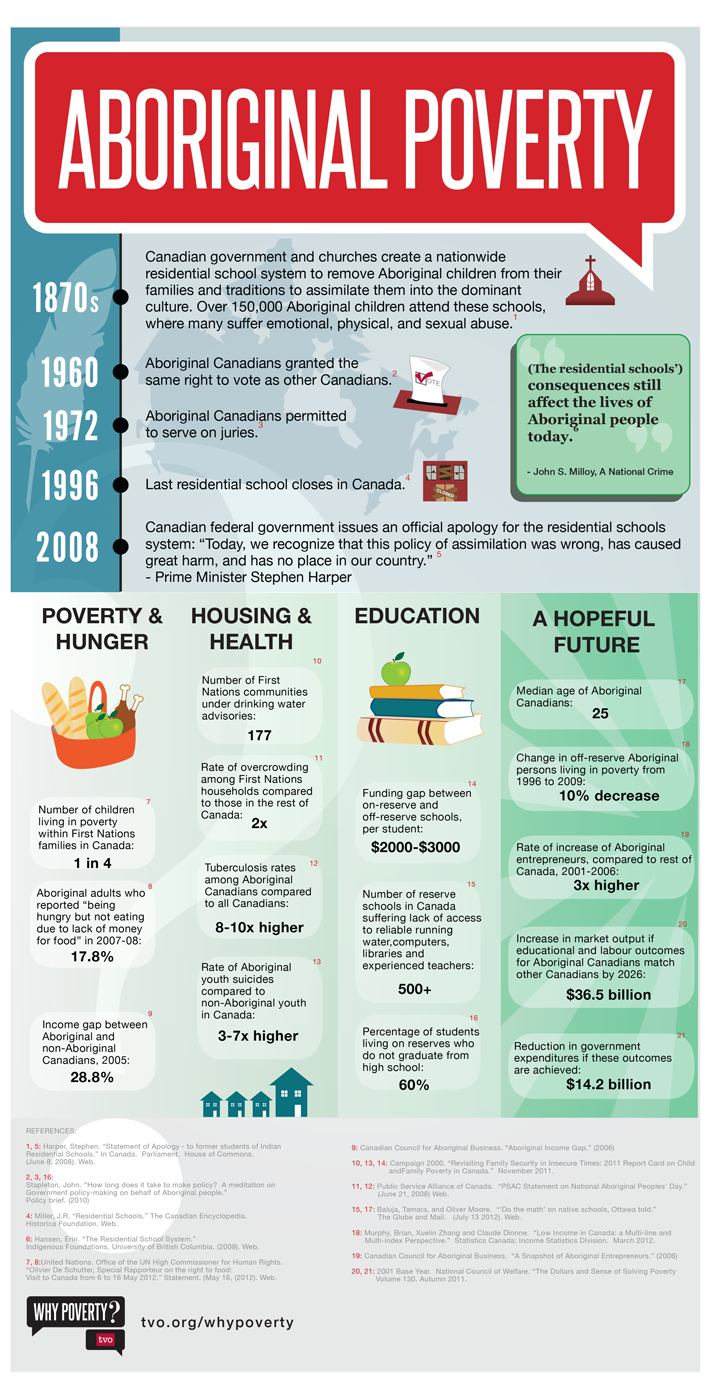The term Aboriginal Peoples refers to Canada's First Nations, Inuit and Metis populations. Together, they constitute Canada's indigenous population. Aboriginal groups have their own distinct and valuable cultural heritage and background. They share a history of oppression and abuse, marked by centuries of historical trauma. Today, Aboriginal populations are more likely than Canada's general population to face barriers when it comes to accessing education, healthcare, nutritious foods and housing. The infographic below, published by TVO as part of their international Why Poverty? campaign, provides some details about Aboriginal poverty in Canada.
When discussing the issue of the rights of Aboriginal Peoples and the difficulties they face in Canada today, one common (and misinformed) remark is that the effects of colonization would have worn off by 2014. Such a thought process makes light of the intergenerational impact that colonization, and a policy of assimilation, can have. Displacement of indigenous communities has had a similar impact in other settler colonies, including Australia and New Zealand. One should also avoid turning a blind eye to the recent federal programs that actively harmed Aboriginal communities. The last Indian residential school only shut down in 1996. Today, there are still policies and practices in place that fail to account for the needs of Canada's Aboriginal population.
Discrepancies in the housing situation for Aboriginal populations compared to the general population. A recent study showed that 1 in 15 urban Aboriginal Peoples experience homelessness, compared to 1 in 128 for the general population. First Nations households are twice as likely to be overcrowded compared to other households in Canada. These differences between Aboriginal Peoples and other Canadians extend to issues of accessibility to food and healthcare. Housing doesn't exist in a vacuum, difficulties in meeting nutritional needs and accessing healthcare directly impact individuals and their ability to lift themselves out of poverty and into a healthy housing situation. These difficulties have a cumulative impact.
One of the primary ways individuals and families can escape the cycle of poverty is through education. Yet, Aboriginal children are poorly supported compared to other youth. In 2006, over 40% of Aboriginal Canadians over the age of 15 had not completed a high school diploma; the bare minimum for most jobs in the Canadian marketplace. According to the infographic, there is also a $2000-$3000 dollar funding gap per student when off-reserve students are compared to students living on-reserve. This serves as one example of how a lack of funding can be perceived as actively discriminating against Aboriginal youth. Many families choose to live on reserves because reserves allow these families to maintain aspects of their culture and heritage. Canada's Aboriginal population should not be in a situation where they have to choose between education and heritage. There should be room for both.
When we consider the structural problems Aboriginal Peoples have to face, one should bear in mind the median income gap that exists between Aboriginal Canadians and non-Aboriginal Canadians (30% in 2005). The way policies and funding are structured have an immediate and direct impact on Aboriginal Canadians. While recent years have shown some improvements in areas of education and entrepreneurship towards improving the wellbeing of Canada's Aboriginal population, there remains a great deal of work to be done. Informed narratives and policies, which take a history of colonization and discrimination into account, will go a long way towards bridging the gap that exists between Aboriginal and non-Aboriginal Canadians.


